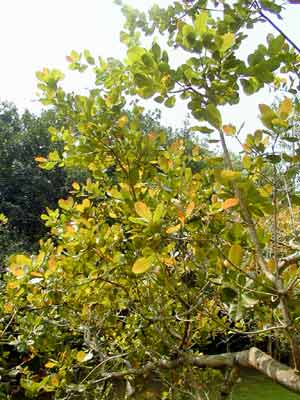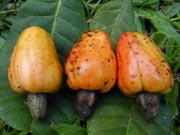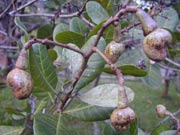 |
|
Cashew Nut |
Cashew nut is ripen
The exuberant cashew nut forest is singing
Have a taste, dear tourists
This cup of sweet liquid
Will make you feel sweet at the bottom of your heart
-----A folk song of Mozambique in Africa
The cashew nut comes from the tropical Africa and it asks for very little from human beings. It can even grow exuberantly in deserted fields or beaches, but it would contribute quite palatable fruits and delicacies for human beings. Cashew
nut has a strong capacity of anti-drought; it blooms and fructifies three times a year; its flower is yellow with light red stripes. For outsiders in botany, they would feel
cashew nut is strange; because its seeds grow outside its fruits and are connected to the lower ends. As a matter of fact, the part we eat as fruits is not the real fruit, but the support of the fruit, or the false fruit; the real fruit refers to the part we call seed. The shape of
cashew nut resembles that of a pear, only that it is much smaller. When the fruits are unripe, they are green; and they would become red when ripen. The fruit is sweet and rich in syrup. It tastes a bit astringent, but is rich in nutrition; it also has high economic values.
 |
|
Cashew Nut |
Cashew nut is a kind of rare dry fruit and high-rank dish. It contains 21% of protein, 40% of oil and a lot of vitamins. On the international markets, each ton of
cashew nut is sold at the price of over 5000 USD, and it is really worthy of the title of
"one of the four dried fruits" in the world. The oil content of the
cashew nut shell is 11%, and its oil could be used to produce compound rubber. If people use the oil to paint their furniture, the furniture could endure high temperatures. It is said that the spacecrafts of the United States are often coated with
cashew nut oil after special treatment.
The planting of cashew nut by human beings has a history of over 4000 years. It originates from Northeast of Brazil, and was introduced to Asia and Africa from the 16th century; and it now scatters in dozens of countries within north latitude 20°, such as Brazil, India, Mozambique, and Hainan Island of China. Hainan has a history of 50 for the planting of Cashew Nut; for the time being, there are 200000 mu of
cashew nut in Hainan Island.
 |
|
Cashew Nut |
In Mozambique of Africa, cashew nut is particularly to the liking of the people. The patterns of
cashew nut could be seen in books, magazines, drawings, advertisement, calendars, and carvings etc.; and it is also painted on furniture, clothing and daily ornaments. A large amount of novels, essays, and poems written on the topic of
cashew nut are also published. During the harvesting seasons of
cashew nut, the farmers would put on their best clothes and pick up
cashew nut in the fields. The folks laugh and sing, and the whole picture is like a great festival.

|